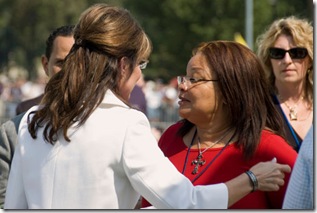Be sure to read: Understanding Earthquakes and Their Impacts: Part I – And Why the U.S. Government Might Be Issuing This first
Posted by Tammy Dickinson and David Applegate on May 11, 2011 at 12:55 PM EDT
Ed. Note: This is the second of a two-part blog focusing on the science and aftermath of earthquakes. Part I focused on the science of a high-magnitude earthquake and whether one could happen in the United States.
Part II: What We Can Do About It
There is nothing we can do to stop the movement of the Earth’s plates or the associated earthquakes, and the recent earthquake in Japan is a reminder that low-probability, high-impact events can strike anytime. This situation demands that nations, communities, and individual families take steps to develop resilience to hazards generally—a process that requires the collective action of government at all levels as well as nonprofit organizations, the private sector, and individuals.
Resilience—in the form of mitigation preparedness activities and improved public understanding—can help ensure that their impacts on society are greatly reduced. Science and technology can play a critical role in the quest for disaster resilience,and scientists and engineers have much to contribute. But doing so requires effective mechanisms to translate and implement their research-derived knowledge. That is precisely the goal of the National Earthquake Hazards Reduction Program (NEHRP)—an interagency endeavor involving the U.S. Geological Survey (USGS), National Institute of Standards and Technology, Federal Emergency Management Agency, and National Science Foundation.
One example of NEHRP’s value is its work translating research into the creation of building codes. Every five years the USGS updates its national seismic hazard maps, which estimate earthquake probabilities for various areas based on past frequency of large earthquakes, seismicity patterns, strain accumulation in the Earth’s crust, and other factors that are the subject of active research. This information forms the basis for FEMA-produced design maps that form the seismic provisions in model building codes adopted in earthquake-prone areas.
Video: ALERT! New Madrid EarthQuake Imminent!!!! PROOF that HAARP is being used! more proof Pt1
Language Warning: I apologize in advance for the occasional curse word that the man who provides the information in the video below uses. Mike is providing some vital information and may be found on You-tube Account: PatrioticSpace. The information is much to important to get out than to worry about occasional bad language. Please be open to the information anyway. Original post by: patrioticspace | January 22, 2011 |
Also: FEMA DHS requesting 14 MILLION emergency meals for the New Madrid Seismic Zone!! (Why would they order all of this, spend all of this money, if they're only "practicing during NLE NMSZ in May of this year?!)
Video: FEMA Prepares for HAARP Earthquake on New Madrid Fault Line
U.S. Government Takes Down HAARP Website to Conceal Evidence of US Weather Modification and Earthquake Inducing Warfare - You be the judge…
Building codes are crucial to mitigating the impact of earthquakes. Consider that rebuilding was the defining challenge in the wake of the devastating magnitude-7 earthquake that struck Haiti in January, while Chile weathered a magnitude-8.8 earthquake the following April with far fewer casualties and less damage, thanks to prudent investments in planning and construction.
The lessons of that contrast were reinforced at a March 2010 workshop convened by the National Science and Technology Council’s Subcommittee on Disaster Reduction along with the State Department and United Nations International Strategy for Disaster Reduction, attended by over 100 leading geoscientists, earthquake engineers, planners, architects, emergency managers, building code officials, and a delegation of Haitian government officials and academics. Key findings from the workshop included the need to adopt and enforce international building codes, especially for construction of schools, hospitals and critical infrastructure being funded by international donors; develop cost-effective design guidelines for residential structures; and incorporate assessments of earthquake, inland flooding, and landslide hazards in the planning and rebuilding process, so that people are not put straight back into harm’s way. The findings also emphasized the central importance of building local science and engineering capabilities as the best way to sustain a more hazard-resilient approach. These recommendations were finalized in a report that was delivered to the donors participating in a major conference the following week in New York, where pledges were made for more than $8 billion in aid. These guidelines have been used to shape investment strategies for the UN, USAID, Clinton Foundation, World Bank, and many other donors.
Understanding earthquakes and their effects is of vital importance to the Nation. As the population increases, expanding urban development and construction works encroach upon areas susceptible to earthquakes. With a greater understanding of the causes and effects of earthquakes and how they impact buildings, infrastructure, and society itself, we may be able to reduce damage and loss of life from this destructive phenomenon. Progress will be slow, excruciatingly so at times, but given the extent to which resilience can benefit communities beyond just the earthquake threat, it is progress worth striving toward.
Tammy Dickinson is a Senior Policy Analyst at the White House Office of Science and Technology Policy
David Applegate is Senior Science Advisor for Earthquake & Geologic Hazards at the US Geological Survey
Related:
US Navy’s Earth Changes USA Flood Map, New Madrid Earthquake ZoneNLE 2011: What Does the Navy Know?
Video: Global Earthquake and Volcano Overview May 9 2011.wmv
Yellowstone Caldera: “What in the World is Happening There”






















No comments:
Post a Comment